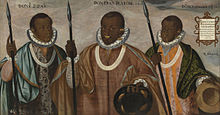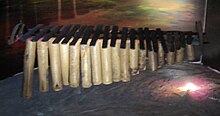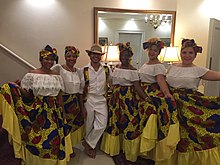Afro-Ecuadorians
Afroecuatorianos | |
|---|---|
 Afro-Ecuadorian girls in traditional clothing. | |
| Total population | |
| 1,120,000(7.2% self identified in 2010 census).[1] | |
| Regions with significant populations | |
| Esmeraldas,Guayaquil,Valle del Chota,Imbabura ProvinceSucumbíos ProvinceSmall minorities live in the U.S., and Spain | |
| Languages | |
| Spanish | |
| Religion | |
| PredominantlyCatholic | |
| Related ethnic groups | |
| OtherAfro-Latin Americans. |
Afro-EcuadoriansorAfroecuatorianos(Spanish), areEcuadoriansof predominantlySub-Saharan Africandescent.[2]
History and background
[edit]
Most Afro-Ecuadorians are the descendants of enslaved Africans who were transported by predominantly British slavers to Ecuador from the early 16th century.[3]In 1553, the first enslaved Africans reached Ecuador in Quito when aslave shipheading to Peru was stranded off the Ecuadorian coast. The enslaved Africans escaped and establishedmaroonsettlements in Esmeraldas, which became a safe haven as many Africans fleeing slave conditions either escaped to there or were forced to live there. Eventually, they started moving from their traditional homeland and were settling everywhere in Ecuador.[4]

Racism, on an individual basis and societally are strongly discriminated against by themestizoandcriollopopulations.[5][6]As a result, along with lack of government funding and low social mobility poverty affects their community more so than the white and mestizo population of Ecuador.[7][8]After slavery was abolished in 1851, Africans became marginalized in Ecuador, dominated by the plantation owners.[9]

Afro-Ecuadorian people and culture are found primarily in the country's northwest coastal region. The majority of the Afro-Ecuadorian population (70%)[10]are found in the province ofEsmeraldasand theValle del Chotain theImbabura Province,where they are the majority.[11]They can be also found in significant numbers inGuayaquil,and inIbarra,where in some neighborhoods, they make up a majority.[12]Many Afro-Ecuadorians have participated in sports, for instance playing with theEcuador national football team,many of whom hail from Valle del Chota.[13]
Culture
[edit]
Afro-Ecuadorian culture may be analysed by considering the two main epicenters of historical presence: the province ofEsmeraldas,and theChota Valley.[14]In Ecuador it is often said that Afro Ecuadorians live predominantly in warm places like Esmeraldas.[15]Afro-Ecuadorian culture is a result of theTrans-atlantic slave trade.[11]Their culture and its impact on Ecuador has led to many aspects fromWestandCentral Africacultures being preserved via ordinary acts of resistance and commerce.[16]Examples of these include the use ofpolyrhythmic techniques,traditional instruments and dances; along with food ways such as the use ofcrops brought from Africa,like thePlantainandPigeon pea,and oral traditions and mythology likeLa Tunda.[17][18][19][20]When women wear their hair as it grows naturally, it is often associated with poverty, which is why successful or upwardly mobile women tended to straighten their hair.[21]
Music
[edit]
Marimbamusicis popular from Esmeraldas to thePacific Region of Colombia.It was considered anIntangible cultural heritagebyUNESCOin 2010.[22]It gets its name from the prominent use ofmarimbas,but is accompanied along with dances, chants, drums and other instruments specific to this region such as thebombo,thecununoand theguasá.[23]

Sometimes this music is played in religious ceremonies, as well as in celebrations and parties. It features call-and-response chanting along with the music. Some of the rhythms associated with it arecurrulao,bambucoandandarele.[24]

On the other hand, in the Chota Valley there isbombamusic. It can vary from mid-tempo to a very fast rhythm. It is usually played with guitars, as well as the main local instrument calledbomba,which is a drum, along with aguiro,and sometimesbombosandbongos.A variation of it played byla banda mocha,groups who playbombawith abombo,guiroand plant leaves to give melody.[25]
Religion
[edit]The religious practice among Afro-Ecuadorians is usuallyCatholic.Catholic worship is distinctive in Esmeraldas, and sometimes is done withmarimba[26][27]
Political framework
[edit]
Numerous organizations have been established in Ecuador to for Afro-Ecuadorian issues. TheAfro-Ecuadorian Development Council(CONDAE).Afro-Ecuadorian Development Corporation(Corporación de Desarrollo Afroecuatoriano, CODAE), institutionalized in 2002,Asociación de Negros Ecuatorianos(ASONE), founded in 1988,Afro-Ecuadorian Institute,founded 1989, theAgustín Delgado Foundation,the Black Community Movement (El Proceso de Comunidades Negras) and TheNational Confederation of Afro-Ecuadorians(Confederación Nacional Afroecuatoriana, CNA) are amongst some of the institutional frameworks in place in Ecuador.[9]TheWorld Bankhas given loans for Afro-Ecuadorian development proposals in Ecuador since 1998, loaning $34 million for related projects between 2003 and 2007, andUSAIDalso monitored the 2006 elections in Ecuador to ensure that Afro-Ecuadorians were not being unfairly underrepresented.[9]
Notable Afro-Ecuadorians
[edit]Historical
[edit]- Alonso de Illescas(1528-1600s), AfricanMaroonleader in Esmeraldas in colonial Ecuador.
- María del Tránsito Sorroza,midwife and formerly enslaved woman.
- Martina Carrillo(1750–1778), Ecuadorian activist, born enslaved, who fought for the rights of Afro-Ecuadorians.
Politics
[edit]Government
[edit]- Diana Salazar Méndez,Attorney General of Ecuador
- Lucía Sosa,Mayor ofEsmeraldasfrom 2005 to 2013 and 2014 to 2018
- Paola Cabezas,first Afro-Ecuadorian presenter ofEcuador TVand politician[28]
Activism
[edit]- Jaime Hurtado,from Guayaquil; known for fighting for the rights of the working people of Ecuador; founder and leader of theDemocratic People's Movement(MPD); assassinated in the winter of 1999[29]
Music
[edit]- Guillermo Ayoví Erazo,EcuadorianMarimbaplayer and singer.
- Karla Kanora,Ecuadorian singer.
- Eddy More, Ecuadorian songwriter.
Literature
[edit]- Adalberto Ortiz(1914–2003), poet, diplomat and author.
- Nelson Estupiñán Bass(1912–2012), poet and author.
Sports
[edit]Bo xing
[edit]- Carlos Andrés Mina,Ecuadorian Light heavyweight boxer
- María José Palacios,Ecuadorian women's Olympic lightweight boxer
- Érika Pachito,Ecuadorian women's Olympic middleweight boxer
Judo
[edit]- Carmen Chalá,Ecuadorian Olympic Judoka.
- Diana Chalá,Ecuadorian Olympic Judoka.
- Vanessa Chalá,Ecuadorian Olympic Judoka.
Discus
[edit]- Juan José Caicedo,Ecuadorian discus thrower that competed in the2020 Summer Olympics
Weightlifting
[edit]- Neisi Dajomes,Gold medalist for women's weightlifting in the 2020 Tokyo Olympics
- Tamara Salazar,Silver medalist for women's weightlifting in the 2020 Tokyo Olympics
- Angie Palacios,Ecuadorian Olympic weightlifter and sister of Neisi Dajomes
- Alexandra Escobar,Ecuadorian Olympic weightlifter
- Oliba Nieve,Gold medalist for women's weightlifting in2007 Pan American Games
Sprinting
[edit]- Álex Quiñónez,Ecuadorian Olympic sprinter; finalist in 200-meter dash at the2012 Summer Olympics
- Ángela Tenorio,Ecuador Olympic sprinter
- Yuliana Angulo,Ecuadorian Olympic sprinter
- Virginia Villalba,Ecuadorian Olympic sprinter[30][31]
Football
[edit]- Adrian Bone
- Alexander Domínguez
- Anderson Julio
- Agustin Delgado,Ecuadorianfootballplayer hailing from Juncal village; signed a $3.5 million deal with the team from Southampton, England in 2001
- Byron Castillo
- Carlos Gruezo
- Christian Benítez
- Darío Aimar
- Sebas Méndez,football player for theOrlando City SC
- Alberto Spencer(1937–2006), football player and all-time top scorer of theCopa Libertadores
- Antonio Valencia,football player forManchester Unitedand Ecuador national team
- Arturo Mina
- Enner Valencia,football player forInternacionaland Ecuador national team
- Brayan Angulo,football player
- Michael Arroyo,football player
- Gabriel Achilier,football player
- Jefferson Lara,football player
- Jairo Padilla,football player
- Juan Cazares,football player
- Jhojan Julio,football player
- Felipe Caicedo,football player
- Miller Bolaños,football player
- Álex Bolaños,football player
- Alexander Bolaños,football player
- Moisés Caicedo,football player
- Moisés Ramírez
- Giovanny Espinoza,football player
- Gonzalo Plata
- Janner Corozo
- Joffre Guerron
- Jorge Guagua
- José Cifuentes
- Jose Valencia
- Juan Cazares
- Jaime Ayoví
- Walter Ayoví
- Diego Palacios
- Pervis Estupiñán
- Ángelo Preciado
- Ayrton Preciado
- Fidel Martínez
- Nilson Angulo
- Segundo Castillo
- Gustavo Vallecilla
- Édison Méndez
- Ivan Hurtado
- Juan Carlos Paredes
- Joao Plata
- Renato Ibarra
- Romario Ibarra
- Robert Arboleda
- Ulises de la Cruz
- Walter Chalá
- Djorkaeff Reasco
- Néicer Reasco
- Rorys Aragón
- Frickson Erazo
- Maximo Banguera
- Oscar Bagui
- Pedro Velasco
- Kevin Rodriguez
- Christian García (Ecuadorian footballer)
Gallery
[edit]












See also
[edit]References
[edit]- ^http:// ecuadorencifras.gob.ec/cpv/[dead link]
- ^"MAR | Data | Assessment for Blacks in Ecuador".mar.umd.edu.Retrieved2021-08-12.
- ^"Up from slavery, Afro-Ecuadorians continue the struggle for their place in society".CuencaHighLife.2018-10-15. Archived fromthe originalon 2020-11-06.Retrieved2021-08-12.
- ^"Afro-Ecuadorian - Afropedea".afropedea.org.Retrieved2021-08-12.
- ^"Much work needed to 'target unacceptable levels' of racism in Ecuador: UN experts".UN News.2019-12-23.Retrieved2021-05-27.
- ^"Afro-Ecuadorians".Minority Rights Group.Retrieved2021-05-27.
- ^"Poverty rates in Ecuador".Statista.Retrieved2021-05-27.
- ^"Government should do more to reduce poverty among Afro-Ecuadorians, UN says".CuencaHighLife.2019-12-26.Retrieved2021-05-27.
- ^abc"Assessment for Blacks in Ecuador".CIDCM. Archived fromthe originalon June 22, 2012.RetrievedAugust 28,2012.
- ^"Esmeraldas and its Afro-Ecuadorian Cultural Legacy".Sounds and Colours.2015-06-19.Retrieved2021-05-27.
- ^ab"How Afro-Ecuadorians shaped the country's culture".Lonely Planet.Retrieved2021-05-27.
- ^"Afro Ecuador – Freedom Is Mine".Retrieved2021-08-12.
- ^"In Ecuador, a poor valley gets a kick start".Christian Science Monitor.2006-12-27.ISSN0882-7729.Retrieved2021-08-12.
- ^"Ecuadorian Culture: Customs, History, Society, Food | don Quijote".donquijote.org.Retrieved2021-05-27.
- ^"Mónica, the first | Translation".Radio Ambulante.2022-04-26.Retrieved2022-05-28.
- ^Ph. D., History; M. A., History; B. A., Rhodes College."There Were 3 Major Ways That Enslaved People Resisted a Life in Bondage".ThoughtCo.Retrieved2021-05-27.
- ^"A Botanical Story of Slavery and the Survival of the Wisdom of Africa".Hidden Garden.2016-08-04.Retrieved2021-05-27.
- ^"Pigeonpea".Crop Wild Relatives.Retrieved2021-05-27.
- ^Breslin, Patrick (2007)."Juan Garcia and the Oral Tradition of Afro-Ecuador".hdl:10644/5940.
{{cite journal}}:Cite journal requires|journal=(help) - ^"La Tunda es un mito afroecuatoriano con fondo emancipador".El Comercio(in Spanish).Retrieved2021-05-27.
- ^Lago, Ivonne."Paola Cabezas:" A la vida hay que ponerle tumbao "".expreso.ec.Retrieved2022-05-28.
- ^"UNESCO - Marimba music, traditional chants and dances from the Colombia South Pacific region and Esmeraldas Province of Ecuador".ich.unesco.org.Retrieved2021-08-12.
- ^Cornejo, Santiago Carcélen; Ordóñez, Fabricio Morales,The Guardians of the Marimba, the Cununo and the Guasa(in Spanish),retrieved2021-08-12
- ^"Discover the Afroecuadorian culture".This Is Ecuador.2019-02-27.Retrieved2021-08-12.
- ^Velasco, Estefanía."La Bomba, símbolo musical de resistencia de la minoría afroecuatoriana".El Comercio(in Spanish).Archivedfrom the original on 2021-08-12.Retrieved2021-08-12.
- ^"Marimba importance on the religious aspects of Afro-Ecuadorians"(PDF).Archived(PDF)from the original on 2014-01-14.
- ^Gonzalez, David; Alarcón, Johis (2019-05-31)."Afro-Ecuadoreans Maintain Identity Through Spiritual Practices".The New York Times.ISSN0362-4331.Retrieved2021-08-12.
- ^"Paola Cabezas:" A la vida hay que ponerle tumbao "".2020-12-21. Archived fromthe originalon 21 December 2020.Retrieved2022-05-28.
- ^"Black Latin America".Archived fromthe originalon 2021-08-29.Retrieved2006-11-29.
- ^"Athletics VILLALBA Virginia Elizabeth - Tokyo 2020 Olympics".Olympics /tokyo-2020/.Tokyo Organising Committee of the Olympic and Paralympic Games.Archived fromthe originalon 2021-08-10.Retrieved2021-08-10.
- ^"'We are one big heart' - how Ecuador's 4x100m women made Olympic history in Silesia | FEATURE | WRE 21 | World Athletics ".worldathletics.org.Retrieved2021-08-10.
External links
[edit]- Centro Cultural AfroecuatorianoWebsite with much information on this subject
